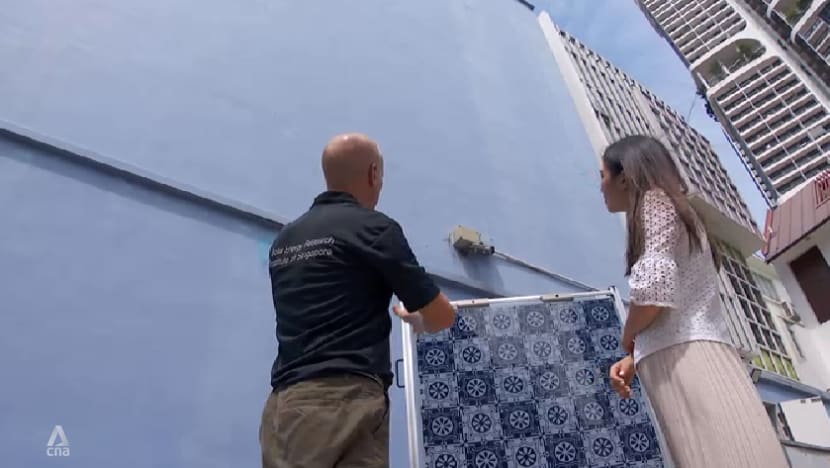Aesthetically pleasing solar panels in the spotlight as demand for solar fittings rise
Aesthetically designed solar panels can be ideal for vertical installations on buildings as Singapore’s demand for green energy rises and rooftops run out of space, experts said.

Mauro Pravettoni from NUS' Solar Energy Research Institute shows CNA journalist Melissa Goh patterned Peranakan-inspired solar modules that are being considered for installation at the NUS Baba House.
SINGAPORE: The blue National University of Singapore (NUS) Baba House is set to go green with solar panels fashioned in Peranakan-style designs fitted into the sides of its building.
These panels will be fitted vertically to the three-storey townhouse located in Singapore’s historic district of Blair Plain, a change from conventional solar panels which are usually placed horizontally on roofs or on the ground.
About 20 to 30 modules will be installed on the west facade of the house, which will allow maximum energy absorption in the afternoons, Mr Mauro Pravettoni from NUS’ Solar Energy Research Institute of Singapore (SERIS), told CNA.
Once fitted with its patterned solar panels and integrated with conventional rooftop panels, the heritage house is expected to save about a-third of its electricity consumption.
The restored townhouse, built around 1895 and once home to a Peranakan Chinese family, is part of the NUS Centre for the Arts.
The artwork on the panels were inspired by Peranakan culture, and tailored to fit with the design of the historic house, said Ms Karen Lim, curator of NUS Museum.
“We wanted something that is customised to Baba House, since (it) is an old heritage house built in the 19th century and we thought that it would give a very special identity to the house itself. It will bring out the hybridity of Peranakan culture in Singapore,’ she said.
Ms Lim hopes that the cultural landmark – a piece of Singapore’s history – will play a vital role in mapping out a greener future for 6,500 shophouses in the country.
“This house to us is not just a house, it’s a living artefact,” Ms Lim said. “When we look into the conservation of the house… all the research database we are collecting will help to further Singapore’s efforts in sustainability.”
“(We want to) educate Singaporeans who own shophouses, and to show that it is possible for them to adopt new energy, renewable energy, and help as a collective effort for Singapore’s management of climate change and global warming,” she said.
SOLAR DEMAND ON THE RISE
Solar installations are on the rise in Singapore.
Fittings at residences went up by 154 and the private sector added 55 fixtures in the first quarter of 2022, compared to the previous quarter, according to numbers released by the Energy Market Authority.
Raising energy costs, awareness, and the global environment are among the factors driving solar adoption, said Mr Lim Cheong Boon, head of Asia Pacific product and marketing at Trina Solar.
“We can also look at it from energy security, because solar itself is something which you install on your roof or within the boundaries of your country, so there’s a security that the energy will always be there, it doesn’t depend on imported energy sources to power your needs,” Mr Lim said.
Singapore's solar deployment goal is to generate enough electricity to meet the annual needs of around 350,000 households by 2030.
Aesthetically designed solar panels like those planned for the NUS Baba House can be ideal for vertical installations on buildings as Singapore’s demand for green energy rises and rooftops run out of space, experts said.
AESTHETICS VS EFFICIENCY
A disadvantage of placing panels vertically means they get less sunlight, and industry players say advanced technology is needed before vertical fittings can be widely used.
“Considering the power generation of the vertical solar, to the conventional tilted installation, the power generation is still less,” said Mr Lim. “So we think the technology still needs to be further matured and developed before we can see widespread adoption of vertical solar.”
While designs on solar panels can improve aesthetics, efficiency will be reduced between 5 and 25 per cent, depending on design and colour, said Mr Pravettoni.
NUS Baba House’s aesthetically pleasing modules will likely see a loss of about 25 per cent on energy absorption compared with plain ones, but Mr Pravettoni said efficiency can be improved by using different material, textures, or designs.
“Colour modules – the real reason why we do that is to harmonise (with) building façade. It belongs to an idea of having modules that are trying to fulfill certain aesthetic needs. In this case, the real novelty is to have repeated patterns,” he said.
Mr Pravettoni explained that identical patterns in the Peranakan-inspired panels allow each cell to receive the same amount of sunlight, which can help to improve their efficiency and safety.
Despite the compromise on energy intake, he said aesthetics are important.
“Clearly aesthetics is important when it’s on a building because nobody wants a building to be ugly. So you want to have a building that is aesthetically appealing to the surroundings and people can look at the building and say: ‘Wow that is amazing. This is PV (photovoltaic)? That’s amazing’”, he said, referring to photovoltaic technology used in solar installations.
HUGE FUTURE POTENTIAL
While vertical installations and patterned panels are still in their early days, researchers see huge potential to integrate these solar installations on the thousands of untapped building facades in Singapore.
“Almost all over the city you have a lot of high-rise buildings and less low-rise buildings. And in high rise buildings, the vertical surface is much larger than the roof,” said Mr Pravettoni.
Apart from attaching solar panels, experts are also looking at integrating solar technology into buildings, and even along roads.
“Another approach is to (replace) a building element such as a window with a photovoltaic building element,” said Mr Pravettoni.
“There’s a lot of work still to be done but if we achieve this goal, then most of the buildings in Singapore can have photovoltaics integrated in their facades,” he said.
“Other ideas are to use (them) as noise barriers such as on the sides of a motorway or railway to act as protection for the noise and meanwhile producing electricity, and these are also installed vertically,” said Mr Pravettoni.



















